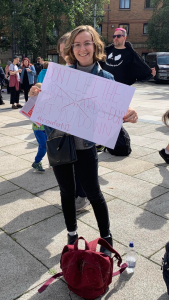
As we look forward to the March for Choice on September 28th, we are sharing blogs from our supporters about what this year’s march means to them. If you would like to contribute to our ‘Why I’m Marching’ blog, please send us written blogs (up to 700 words) or video blogs (up to 1 minute, including captions) to [email protected]
Today’s blog post comes from Makayla Haussler who is a member of ARC’s Policy and Advocacy working group. #ARCMarch19 #NoOneLeftBehind
With the repeal of the 8th Amendment fading in the rear-view mirror, many people may find themselves wondering why there is yet another March for Choice being organized this year. The 8th Amendment is gone, abortion is legal in Ireland; the goal has been achieved. So, what is there left to be done?
As an American, my country’s experience has taught me that abortion rights are always under threat and that we must remain vigilant. I’m marching this year because I know that legality is not the same as access and normalisation. In the U.S., the 1973 Supreme Court decision in Roe vs. Wade legalised first trimester abortions nationwide. Future generations of people would never have to know what it was like when illegal, back-alley abortions were one of the leading causes of maternal mortality, especially among women and people of colour. With abortion legalised, many feminist activists turned their attention to other issues, and abortion gradually faded from the national headlines. Legalisation provided a security that resulted in complacency, creating an opportunity for anti-abortion forces to find new and creative ways to restrict abortion access. These included mandatory waiting periods, requiring doctors to deliver inaccurate medical information about abortion, and forcing minors to get parental consent before having an abortion. Now, even though abortion has been legal in the U.S. for nearly fifty years, abortion access has deteriorated to the point where it is practically inaccessible for many of the people who need it.
I’m marching because I want to help prevent Ireland from following the path set by the United States. Striving for full reproductive rights and justice requires that we remain vigilant in ensuring that no one is left behind, and that safe, accessible, and local abortion is a reality for everyone. Looking at the existing abortion law in Ireland, there are many opportunities for improvement. Currently, there is a mandatory three-day waiting period before someone can have an abortion. Waiting periods are paternalistic, implying that pregnant people are incapable of making thoughtful decisions on their own. Waiting periods also create logistical difficulties for people who may have to travel or arrange time off work to accommodate the waiting period. For people living in one of the four counties with no abortion providers, this policy represents a serious barrier to accessing an abortion. Further problems are faced by asylum seekers living in Direct Provision, as people who are new to Ireland may not be fully aware of their legal rights or of all the law’s requirements, including a 12-week cut-off for abortion on request. Limited English proficiency and the geographical isolation of many Direct Provision centres are additional impediments that make it more difficult for asylees to navigate accessing an abortion.
Another major way in which the full promise of the Repeal vote has yet to be enacted is in the ongoing debate over the creation of safe access zones. Legalizing abortion didn’t magically eradicate abortion stigma; ensuring that patients are able to safely enter clinics is therefore a crucial part of upholding the promise of safe and accessible abortion. One need only to look to the United States, where very few states have a safe access zone policy, to see why these laws are so important. Even in my progressive college town, anti-abortion protesters would surround our clinic on weekend mornings, wielding graphic signs and shouting insults at patients and staff. Luckily, our clinic had a private parking lot, which mostly protected our patients as they made their way to our doors. Many other providers across the country are not so lucky, and protesters often attempt to physically obstruct patients from entering the clinic. Anti-abortion activists acknowledge that these protests are a strategy that is intended to terrorize patients and make them too ashamed and scared to enter the clinic. The fact that clinics are the primary site of anti-abortion protest is significant: if these protests were about expressing political speech, then they would target government buildings, not clinics or doctors’ homes. Marching is a way to voice your support for safe access zone policies that will ensure that patients are able to access health care without fear of intimidation or even physical violence.
With so much work to be done here in Ireland, this year’s March for Choice is more important than ever. People in power and anti-abortion forces are expecting that we’ll let up, now that abortion is legal. We must show them that we’re not going away and that we’ll continue to fight for an Ireland in which the promise of free, safe, legal, and local abortion care is a reality for everyone on the island. There are so many improvements that are yet to be made, and so many gains that must be defended. We must resist falling into complacency, we must keep striving toward reproductive justice, and we have to keep marching.

